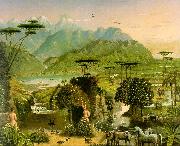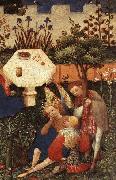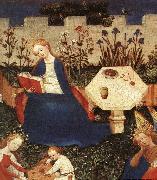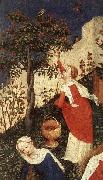
Oil On
Canvas, Real Flavor of Old Masters
|
Erastus Salisbury Field
|
|||
|
|
|||
| 1805-1900 American painter. He studied with Samuel F. B. Morse in New York during the winter of 1824-5. On his return to the rural isolation of Leverett, MA, he painted his earliest known work, the portrait of his grandmother Elizabeth Billings Ashley (Springfield, MA, Mus. F.A.). His career as an itinerant portrait painter began in 1826, most of his commissions coming through a network of family associations in western Massachusetts and Connecticut. The portraits of 1836-40 are considered his best. From 1841 he lived mainly in New York, where he expanded his subject-matter to include landscapes and American history pictures. There he presumably studied photography, for on his return to Massachusetts he advertised himself as a daguerreotypist. His few portraits painted after 1841 are copied from his own photographs and lack the expressive characterization and decorative power of his earlier work. From 1865 to 1885 his paintings were based primarily on biblical and patriotic themes. The Historical Monument of the American Republic (1867-88; Springfield, MA, Mus. F.A.) stands alone in American folk art in size (2.82*3.89 m), scope and imaginative vision. Inspired by plans for a national celebration of the centennial of the USA in 1876, Field painted an architectural fantasy of eight towers linked by railway bridges and trains at the tops, with the history of the USA in low-relief sculpture on the exterior surfaces of the towers. Field added two more towers to the painting in 1888 and thereafter retired. | |||
|
|
|||
|
|
The Garden of Eden Erastus Salisbury Field2.jpg Painting ID:: 4020 Visit European Gallery |
1865 | |
Height Width |
INS/CM |
||
|
X |
|
||
|
|
|||
|
unknow artist
|
|||
|
|
|||
|
|
|||
|
|
The Garden of Eden new21/unknow artist-533239.jpg Painting ID:: 63557 Visit European Gallery |
1410 Tempera on wood St?delsches Kunstinstitut, Frankfurt The other tree in the Garden is that of Knowledge, which is also the Tree of Death. It is embraced by the youthful St Sebastian, whose martyrdom (he was tied to a tree and killed by arrows) may be related to the crucifixion of Jesus. The figures sitting in front are easily recognizable by their attributes: the Archangel St Michael by the monkey-like monster cowering at his feet, who is the vanquished Satan himself; St George by his knightly clothes and by the corpse of the dragon, the embodiment of earthly wickedness.Artist:UNKNOWN MASTER, German Title: The Garden of Eden (detail) Painted in 1401-1450 , German - - painting : religious | |
Height Width |
INS/CM |
||
|
X |
|
||
|
|
|||
|
unknow artist
|
|||
|
|
|||
|
|
|||
|
|
The Garden of Eden new21/unknow artist-565549.jpg Painting ID:: 63558 Visit European Gallery |
1410 Tempera on wood St?delsches Kunstinstitut, Frankfurt Mary appears in her usual colours, blue and red. Her attributes are illustrated by the flowers richly carpeting the foreground (lilies and lilies of the valley = purity; rose = illumination; violets = modesty and humility) . These flowers, which were also used for medicinal purposes, frequently became connected with the person of the Madonna. In a fourteenth-century poem from the Netherlands, surviving in manuscript form, twelve different flowers refer to Mary, eight of which can be found in this painting.Artist:UNKNOWN MASTER, German Title: The Garden of Eden (detail) Painted in 1401-1450 , German - - painting : religious | |
Height Width |
INS/CM |
||
|
X |
|
||
|
|
|||
|
unknow artist
|
|||
|
|
|||
|
|
|||
|
|
The Garden of Eden new21/unknow artist-985465.jpg Painting ID:: 63559 Visit European Gallery |
1410 Tempera on wood St?delsches Kunstinstitut, Frankfurt Into the picture of love and undisturbed idyll enters music as the Child Jesus, assisted by St Catherine of Alexandria, plucks on a psaltery. Beyond expressing harmony, music in this picture also refers to the divine nature of this human Jesus. The duality of his being is also intimated by a cherry tree - here substituting for a tree of life - with its twin trunk and bough, from which St Dorothy picks fruit.Artist:UNKNOWN MASTER, German Title: The Garden of Eden (detail) Painted in 1401-1450 , German - - painting : religious | |
Height Width |
INS/CM |
||
|
X |
|
||
|
|
|||










